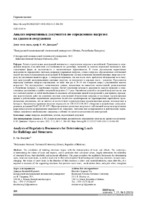| dc.contributor.author | Давыдов, Е. Ю. | |
| dc.coverage.spatial | Минск | ru |
| dc.date.accessioned | 2022-11-11T10:54:03Z | |
| dc.date.available | 2022-11-11T10:54:03Z | |
| dc.date.issued | 2022 | |
| dc.identifier.citation | Давыдов, Е. Ю. Анализ нормативных документов по определению нагрузок на здания и сооружения = Analysis of Regulatory Documents for Determining Loads for Buildings and Structures / Е. Ю. Давыдов // Наука и техника. – 2022. – № 5. – С. 386-391. | ru |
| dc.identifier.uri | https://rep.bntu.by/handle/data/122351 | |
| dc.description.abstract | Расчет строительных конструкций начинается с определения нагрузок и воздействий. Правильность определения нагрузок и воздействий, и в особенности их расчетных значений, во многом определяет надежность конструктивных форм, их долговечность и экономическую эффективность. В статье рассмотрены нормативные документы по определению снеговых, ветровых и крановых нагрузок, а также нагрузок, обусловленных собственной массой несущих и ограждающих конструкций. В большинстве случаев изменение значений снеговых нагрузок в сторону их увеличения является трудо- и материалозатратным, так как после этого требуются обследование всех несущих конструкций, воспринимающих снеговые нагрузки, их перерасчет и довольно часто – усиление. Предлагается пересмотр снеговых нагрузок производить не чаще чем раз в 20–25 лет. Скорость ветра с увеличением высоты возрастает. Это подтверждают статистические данные, полученные на множестве метеостанций, расположенных в Республике Беларусь и зарубежных странах. Неучет изменения ветрового давления по высоте приводит к существенному увеличению усилий от ветровой нагрузки в 2–3 раза. Увеличение усилий от ветровой нагрузки так же, как и от снеговой, влечет за собой необходимость массового обследования зданий и сооружений и, как правило, проведения дорогостоящих работ по усилению несущих конструкций. Определение нагрузок от мостовых грузоподъемных кранов в действующих нормативных документах полностью ориентировано на характеристики европейских грузоподъемных механизмов, что во многом не соответствует характеристикам грузоподъемных кранов, используемых в Беларуси. Предлагается крановые нагрузки определять по СП 20.133330.2011 «Нагрузки и воздействия» (актуализированная редакция СНиП 2.01.07–85*). При определении расчетных нагрузок от собственной массы конструктивных форм используются коэффициенты надежности по нагрузкам. Значения этих коэффициентов в действующих нормативных документах необоснованно завышены, особенно это касается металлических конструкций. | ru |
| dc.language.iso | ru | ru |
| dc.publisher | БНТУ | ru |
| dc.title | Анализ нормативных документов по определению нагрузок на здания и сооружения | ru |
| dc.title.alternative | Analysis of Regulatory Documents for Determining Loads for Buildings and Structures | ru |
| dc.type | Article | ru |
| dc.identifier.doi | 10.21122/2227-1031-2022-21-5-386-391 | |
| local.description.annotation | The calculation of building structures begins with the determination of loads and effects. The correctness of determining the values of loads and impacts, and in particular their calculated values, largely determines the reliability of structural forms, their durability and economic efficiency. The paper considers the regulatory documents for determining snow, wind and crane loads, as well as loads due to their own weight of load-bearing and enclosing structures. In most cases, changing the values of snow loads in the direction of their increase is labor- and material-intensive, since after this, it is required to examine all the supporting structures that perceive snow loads, recalculation them, and quite often, strengthen them. It is proposed to review snow loads no more than once every 20–25 years. Wind speed increases with height increases. This is confirmed by statistical data obtained at many weather stations located in the Republic of Belarus and foreign countries. Failure to take into account the change in wind pressure along the height leads to significant increase in the efforts from the wind load by 2-3 times. The increase in the efforts from the wind load, as well as from the snow load, entails the need for a mass survey of buildings and structures and, as a rule, expensive work to strengthen the supporting structures. Determination of loads from overhead cranes in the current regulatory documents is completely focused on the characteristics of European hoisting mechanisms, which largely does not correspond to the characteristics of cranes used in the Republic of Belarus. It is proposed to determine crane loads according to SP [Sanitary Regulations] CYbG20.133330.2011 “Loads and impacts” (updated edition of SNiP [Construction Standards and Regulations] 2.01.07–85*). When determining the design loads from the own mass of structural forms, the reliability factor for loads is used. The values of these coefficients in the current regulatory documents are unreasonably high, especially for metal structures. | ru |

